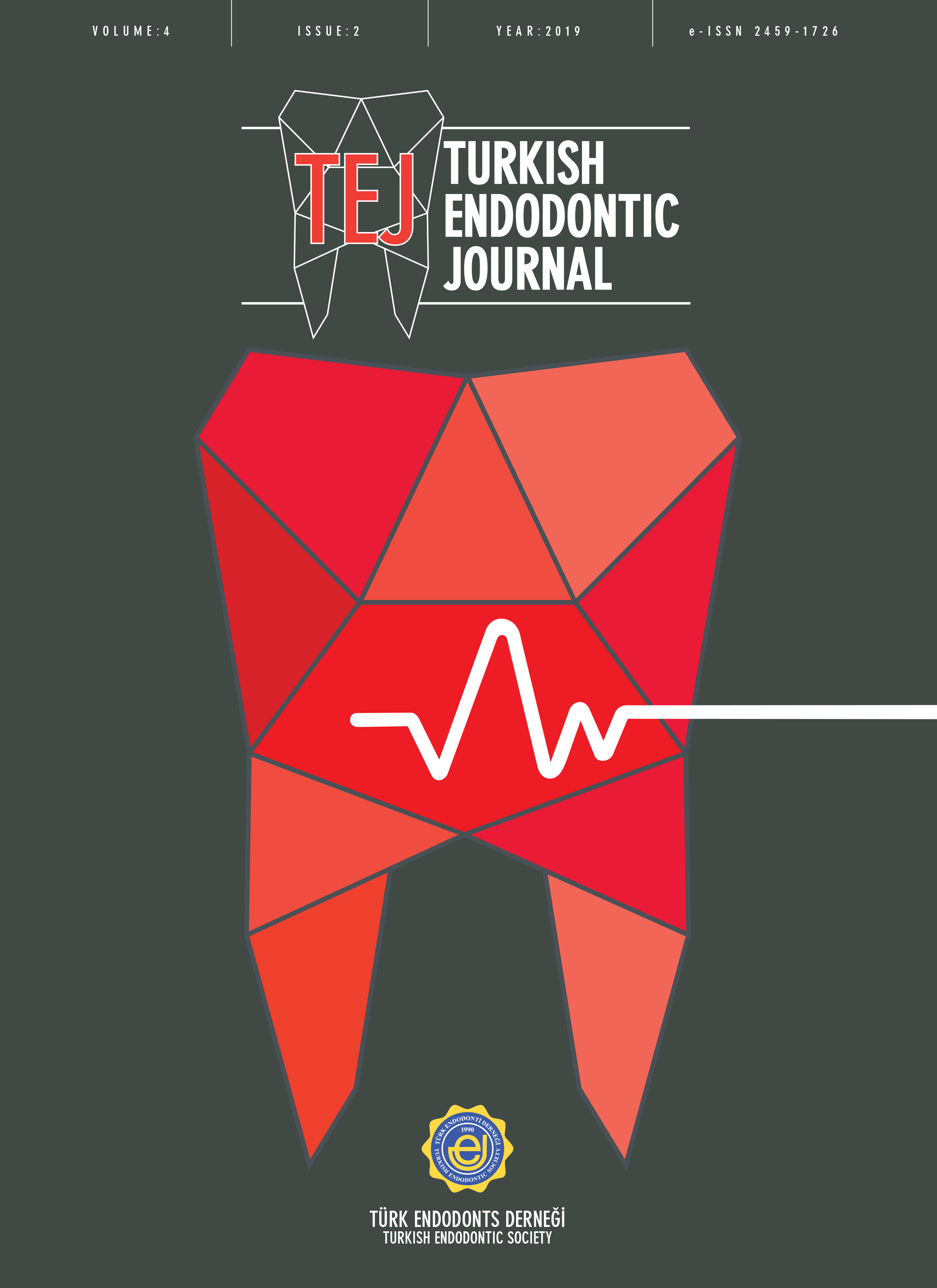Volume: 4 Issue: 2 - 2019
| 1. | Contents Page I |
| ORIGINAL RESEARCH | |
| 2. | Apical periodontitis epidemiology: A population-based survey of students in Dakar, Senegal Khaly Bane, Diouma Ndiaye, Anta Seck, Wendpoulomdé Aimé Désiré Kaboré, Fatou Leye Benoist, Babacar Touré doi: 10.14744/TEJ.2019.80299 Pages 23 - 26 Objective: The objective of the present study was to determine the prevalence of apical periodontitis among students at a university in Dakar, Senegal and to assess the associated factors. Methods: This was a cross-sectional, descriptive, epidemiological study conducted during the academic year 2016–2017 (December 2016 to May 2017). The study population consisted of students in the law faculty and the dentistry department of a university. The age of the subjects was between 20 and 42 years. Each student underwent a clinical examination and a cone beam computed tomography examination. Results: The findings indicated that the prevalence of apical periodontitis was 12%. The lower first molar was the most affected tooth (33.33%). Defective endodontic treatment was the most common cause of apical periodontitis (42.8%). Conclusion: The results of the present study showed that poor endodontic treatment was the most common cause of apical periodontitis. Greater knowledge of apical periodontitis and strategies to improve prevention are needed. |
| 3. | Emergency management of acute irreversible pulpitis with periapical injection of methylprednisolone Khaly Bane, Seydina Ousmane Niang, Yolande Gnagne-Koffi, Wendpoulomdé Aimé Désiré Kaboré, Babacar Touré doi: 10.14744/TEJ.2019.39974 Pages 27 - 33 Objective: A periradicular injection of corticosteroid has been reported to have considerable efficacy in the emergency treatment of acute irreversible pulpitis. The aim of the present study was to examine these findings and to document the drug intake over a period of a week in patients receiving this treatment. Methods: A total of 31 patients who presented with acute irreversible pulpitis pain at the dental clinics affiliated with the university teaching hospital in Dakar, Senegal underwent a periradicular injection with methylprednisolone acetate for emergency pain management. The patients were followed up at 1 week to evaluate the therapeutic outcome of their treatment and drug use. Results: The treatment took approximately 8 minutes to perform. Immediately after the injection, 71% of the patients exhibited no spontaneous pain, and 87.1% had no pain on tooth percussion. On day 7, 77.4% of the patients were reassessed. The evaluation of the analgesic efficacy of the therapeutic procedure on the 24 available patients revealed a sum of pain intensity difference of 12.19 and a sum of pain percussion intensity difference of 0.77. The follow-up indicated that 58.3% required no pain medication on day 2 and 83.3% of patients used no pain medication on day 5. Ibuprofen was used by 37.5% of the patients on day 2 and by 4.2% on day 5. Paracetamol/codeine was used in 29.2% of the cases on day 1 and 4.2% of the cases on day 5. Conclusion: The present study established that methylprednisolone injection for acute pulpitis is a feasible means to provide minimally invasive pharmacological relief and conserve dental resources. |
| 4. | Root canal preparation using continuous rotation: The level of knowledge and the frequency of use in Abidjan, Côte d’Ivoire Marie Chantal Avoaka-Boni, Stéphane Xavier Djolé, Yolande Gnagne-Koffi, Cynthia Noelle Gnaba Nassi, Wendpoulomdé Aimé Désiré Kaboré doi: 10.14744/TEJ.2019.09719 Pages 34 - 38 Objective: Mechanization of canal preparation has made the operative procedures for root canal treatment (RCT) less tedious. The objective of the present study was to establish the level of knowledge of dentists in the city of Abidjan, Côte d’Ivoire regarding mechanized techniques and the frequency of use. Methods: A survey was conducted among 145 practitioners over a period of 3 months. Data collected included the length of time in the profession, the type of practice, the frequency of RCT performed, and the mechanical systems used. A descriptive analysis was performed based on the calculation of numbers and percentages. Results: The majority of dentists (66%) had been engaged in the profession for >10 years. More than half of the surveyed practitioners performed 5 RCTs/week on average. While 73% of the dentists were aware of the existence of mechanical preparation, only 22% used it. The HERO system (Micro-mega, Besancon, France) was the most commonly used (40%), followed by the ProTaper system (Dentsply-Maillefer, Ballaigues, Switzerland) (24%), and the Coronal Median Apical system (CFPM, Tremblay-en-France, France) (16%). Conclusion: The present study revealed that practitioners trained in the past 10 years were more knowledgeable of mechanized canal preparation using continuous rotation, but very few of them used nickel-titanium files in practice. |
| CASE REPORT | |
| 5. | Treatment of maxillary central incisors with internal resorption: Two case reports Güneş Karakaya, Görkem Can, Dilek Türkaydın, Emre İriboz, Hesna Sazak Öveçoğlu doi: 10.14744/TEJ.2019.64936 Pages 39 - 43 Internal root resorption is a rare condition, but it may require complex treatment protocols, depending on the progression. The aim of this case report is to present the treatment protocol and the follow-up results for 2 cases of a right upper central incisor with internal root resorption. A 15-year-old female patient presented with the chief complaint of dental caries. The radiological examination revealed that tooth #21 had internal resorption (IR) in the middle third of the root. The warm vertical condensation technique was applied using a warm obturation system. At 3 years, the tooth was asymptomatic and no lesions were observed. A 48-year-old female patient was referred to the clinic for a routine control. The radiological examination revealed IR in the middle third of tooth #21. As the resorption area was quite wide, cone beam computed tomography was used. The results indicated that there was also external resorption in the buccal part of the root. Therefore, the treatment protocol was changed and the IR area was sealed with mineral trioxide aggregate. At 1 year, the tooth was asymptomatic and no lesions were observed. |


















